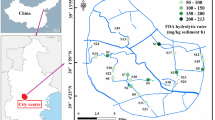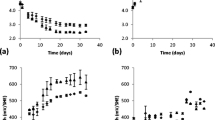Abstract
Background, Aim and Scope
Microorganisms play an important role in the biogeochemical cycles of soils and sediments; hence the microbiological quality of these environments can be evaluated by measuring microorganism population densities, diversity and enzyme activity. For example, dehydrogenase activity is known to be sensitive to pollutants, such as heavy metals, and to correlate with the carbon cycle. This article presents an optimized protocol for measuring dehydrogenase in a range of different sediments and, more precisely, in urban storm-water sediments. The influence of blank preparation, ratio substrate/sediment and time of formazan extraction was studied on sediments coming from urban sewage works, or lakes and rivers.
Materials and Methods
After a microbial and chemical characterization of the sediments studied, the initial protocol of dehydrogenanse measurement consited in incubating 2 g of dry sediment with 2 µmol of INT (the substrate) at 37°C for 24 hrs. It was carried out on three different urban storm-water sediments. Once an optimum dehydrogenase activity was obtained, the new protocol was tested on six other sediment materials.
Results
The results for all the sterilized samples were significantly different to those obtained for the corresponding, non-sterilized sample, with the exception of the St Vallier sediment, which was treated with formaldehyde or the maximum dose of gamma radiation. Sediments that are rich in organic matter must be treated with high concentrations of INT in order to reach, or approach, substrate excess, especially if it is intended to compare formazan measurements. In order to more easily achieve excess substrate, we investigated the possibility of reducing the quantity of solid matter used for the tests. For the two samples tested, and especially for the road basin sample, tests carried out using a ratio of sediment mass (in g) to INT quantity (in µmol) of 0.05 (0.5 g of sediment/10 µmol INT) produced values of 2000-2200 µg of formazan/g of sediment/24 hrs. Activities are much lower (between 1.5 and 3 times lower) when the ratio is equal to 0.2. Sonication should increase formazan extraction as it separates aggregates, thereby improving the contact between the acetone and the sediment. Sonication has an effect on the extraction of formazan. For sample EC2, 30% more formazan was extracted with sonication than without.
Discussion
Sterilization by formaldehyde and by autoclaving demonstrated very different levels of activity. Autoclaving is the least satisfactory sterilization method, as the modifications it causes, especially to the sediment texture, are too great (Trevors 1996). The main advantage of sterilization by irradiation is the minimal disturbance of the sediment structure (Trevors 1996, McNamara et al. 2003). The quickest and most economic sterilization method is the use of formaldehyde. Therefore, blanks sterilized using formaldehyde were used in the tests of the different methods. Organic matter absorbs INT salts, so they are no longer bioavailable for the microorganisms. Sediments that are rich in organic matter must be treated with high concentrations of INT in order to reach, or approach substrate excess, especially if it is intended to compare formazan measurements. Based on our results, the results reported in the literature and practical considerations, such as the solubility of INT and the toxicity of INT with respect to bacteria (Hatzinger et al. 2003), we decided to use a quantity of INT equivalent to 10 µmol (i.e. 2.5 mM in a final concentration in the test) for our subsequent experiments, even though we realized this would not produce saturation conditions for the highly organic sediments. In order to more easily achieve excess substrate, we investigated the possibility of reducing the quantity of solid matter used for the tests. The literature shows that previous work has often been carried out using 1 g samples of dry soil or dry sediment (Merlin et al. 1995, Taylor et al. 2002, Benitez et al. 2004, Plaza et al. 2004). Here, we find a direct relation between the amount of sample and the reduction of the substrate. To ensure that samples remained representative, it was decided not to test samples of less than 0.5g dry weight. Acetone was chosen as the extractant, as it has been used by many other workers (Brohon 1998, Engelen et al. 1998). Sonication has an effect on the extraction of formazan. Kruskal and Wallis tests, at p=0.05, show that the increase of INT extraction is significant for EC2 at 10 minutes, but not for EC1. EC2 is much coarser (around 75% sand and 25% silt) than EC1 (40% sand and 60% silt) (data not shown). This difference in grain size distribution may be one explanation for the different behavior of the two matrices when subjected to sonication .This pretreatment is known to destroy aggregates. Therefore, in order to measure the maximum activity, the acetone extraction time, with or without ultrasound, must be chosen to suit the matrices being studied. So, depending on the characteristics of the sediment (mostly the grain size distribution), it may be useful to use ultrasound in order to achieve a good level of formazan extraction. The method to be used must be determined for each sediments.
Conclusions
When tested on different types of sediment (river, urban sewage, etc.) the optimized protocol (0.5 g sediment and 10 µmol of INT) gave higher activity measurements than the initial protocol and appears to provide a useful test method for comparative studies or for monitoring sediment quality. The organic matter content appeared to be one the most important parameter controlling the measurement and playing an important part on the different contact and extraction steps of the experiment. The best method for preparing blanks is sterilization using gamma radiation, as this has the lowest impact on sediment structure. However, if cost and time considerations render this method impracticable, samples can be sterilized using formaldehyde.
Recommendations and Perspective
: The final protocol can be used to monitor the spatial (in terms of the different vertical and horizontal zones at the surface) and temporal (monitoring changes in activity over time using surface samples taken after different rain events) evolution of this activity within sediment samples from rainwater infiltration basins.
Similar content being viewed by others
Author information
Authors and Affiliations
Corresponding author
Rights and permissions
About this article
Cite this article
Neto, M., Ohannessian, A., Delolme, C. et al. Towards an Optimized Protocol for Measuring Global Dehydrogenase Activity in Storm-Water Sediments (10 pp). J Soils Sediments 7, 101–110 (2007). https://doi.org/10.1065/jss2007.02.206
Received:
Accepted:
Published:
Issue Date:
DOI: https://doi.org/10.1065/jss2007.02.206




